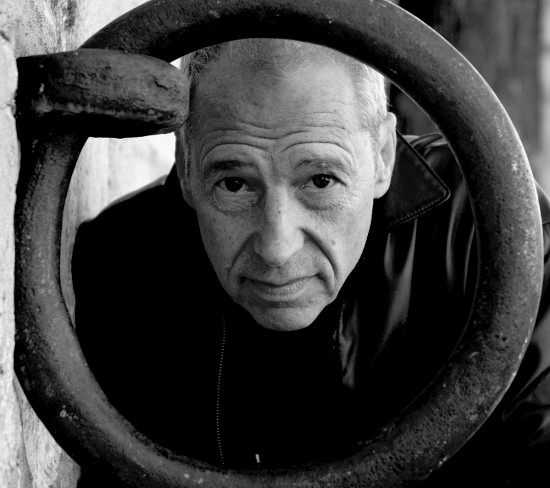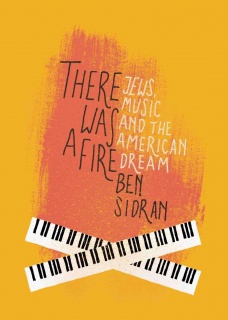
(Editor's note: The venue for Ben Sidran's December 9 lecture has changed since this article was published, and admission fees for both events have also changed.)
Ben Sidran is best known as a jazz pianist and producer; for his work with the Steve Miller Band (he co-wrote "Space Cowboy"); and as host of public radio's Jazz Alive and VH-1's New Visions series. But he also holds a Ph.D. in American studies, and his 2012 book There Was a Fire: Jews, Music, & the American Dream displays not only the storytelling gift and playfulness you might expect from an accomplished songwriter, but also an erudite and thoughtful mind befitting his academic credentials.
It's the mingling of those different facets, however, that makes the book such a compelling read: a love of tales, a deep curiosity about history, the use of personal narrative to ground points in contemporary and emotional life, the creativity to unearth surprising connections, and the jazz artist's willingness to follow a muse or idea wherever it might lead.
All those components will be evident when Sidran visits Davenport as part of the Jewish Federation of the the Quad Cities' "Jews Rock" series: a solo lecture and performance based on his book on December 9 at Temple Emanuel, and a performance by the Ben Sidran Quartet on December 10 at the Redstone Room.
In an e-mail interview while in Europe, Sidran said the two events will play off each other: "The lectures that I do around There Was a Fire are solo, of course, but they do include my playing piano to 'illustrate' ideas and songs. Primarily, I like to tell stories ... , interweaving history and philosophy and painting a picture of how a very small group of people, Jewish immigrants who never made up more than 2 percent of the population, really helped formulate the 'American Dream' and shape American popular culture.
"The quartet performance in some ways will be connected - as it will be related to the subject of the lecture - so I will probably do only compositions by Jewish musicians (Gershwin, Arlen, Dylan, me, etc.). And I do tend to talk a lot on stage ... but the truth is I never know what I'm going to do until I do it."
The book's primary subject is historical, answering a question that Sidran poses in its introduction: "What is Jewish about American popular music?" He summarized in our interview: "The Great American Songbook, the music-publishing business, the modern Broadway musical, the integration of pop music and social narrative, [and] the recording business as we know it all owe their existence to a group of Jewish immigrants or children/grandchildren of those immigrants."
Right at the outset of There Was a Fire, however, it's clear that the author's interests are more personal and wide-ranging than that description would suggest.
Sidran intertwines the experience of his bar mitzvah with his love of his father's jazz records, riffing on the enigmas of both. After his bar mitzvah, he writes, he sat down with his records, and "when I listened to them - miraculously! - I felt connected to something both serious and mysterious (everything religion was supposed to be but, for me, clearly was not). In time, I came to understand that I had a much better chance of resolving the secrets of jazz than unraveling the riddles of Judaism."
Sidran isn't claiming that music is equivalent to religion; rather, he's saying that they can serve similar human needs. And he thus puts music - and popular music in particular - in a position of great spiritual and cultural import, essential and not in any way disposable.
He describes in the book his late-arriving revelation about the function of popular music: "I had recorded 30 solo albums, produced dozens more for other musicians, toured conscientiously, and even recorded with Blue Mitchell himself. I knew well that fortunes had been made and lost, lives saved and sacrificed, hope restored and destroyed, all, in part or in principle, through the music. Clearly, American popular music was more than just the soundtrack of our generations; it was both a river of emotion and a powerful social force. But never did I think about my own place in that ongoing rush - how or why I myself may have turned to the music for solace, meaning, and deliverance."
If that sounds serious and perhaps hyperbolic, understand that Sidran approaches the book with humor and a nimble mind - bringing history to life using easy-to-grasp comparisons. King David, he writes, was the world's first rock star - and he includes in that all the excess and trappings that go along with the term today.
He compares blackface performers to Kiss.
And he writes in another section: "One way to think of early minstrelsy is as a kind of proto-rock-and-roll. It appealed primarily to young men out to have some fun, the first signs of a rebellious youth culture in the newly forming America. Even the instruments used to play the music ... were considered rude at the time, noise to the refined ear. ... (Think of the Rolling Stones a hundred years later.)"
 He also brings his musician's training to the undertaking. He notes that a defining characteristic of Yiddish humor is, as Shostakovich said, "laughter through the tears." This is similar, Sidran writes, to the fact of music that "every major scale contains a minor scale within it," facilitating an easy transition between moods: "It is an emotional quality found in Jewish music as well, where the shift from minor to major and then back to minor again has the similar effect of dark meeting light, of the sun breaking through the clouds, if only for a moment, offering hope before we are once again plunged back into the reality of existential despair."
He also brings his musician's training to the undertaking. He notes that a defining characteristic of Yiddish humor is, as Shostakovich said, "laughter through the tears." This is similar, Sidran writes, to the fact of music that "every major scale contains a minor scale within it," facilitating an easy transition between moods: "It is an emotional quality found in Jewish music as well, where the shift from minor to major and then back to minor again has the similar effect of dark meeting light, of the sun breaking through the clouds, if only for a moment, offering hope before we are once again plunged back into the reality of existential despair."
But the author also highlights a connection between music and the flexible, always-evolving Yiddish language - a personality that's still an essential part of popular music today: "It would be hard to overestimate the importance of Yiddish to the development of popular music in America. Yiddish was the first grammar to capture what would ultimately become a peculiarly American sensibility: It swings, it is inherently musical; Yiddish words often sound like what they mean (shpritz, kvetch, putz). It allowed for the constant generation and regeneration of new words (it wasn't fixed or arbitrated from above); it was tumultuous, built on dualities and dichotomies ... ."
The genesis of There Was a Fire was a 2003 course that Sidran taught at the University of Wisconsin: "Jews, Music, & the American Dream," which he said traced "the history from Irving Berlin to the Beastie Boys. After teaching the course, it was obvious there was no one text that covered the subject, and that I had the material outlined in my lecture notes. But the more I looked into it, the more I realized I had just scratched the surface. ...
"I don't think I had much of the detail filled in when I started writing - I had an idea of the major issues (monotheism, social justice, alienation, etc.) - and as I filled in the spaces I found a lot of information and was able to refine my thinking in these areas. Especially regarding the relationship of blacks and Jews in the early part of the [20th] Century."
The book, he noted, turned out to be a mammoth undertaking. "I had a sense of where the book was headed, but honestly I had no idea of what an enormous task it would be. If I had, I might well have made excuses and not gone down that road. ...
"There Was a Fire was the hardest thing I ever tried to do - it took seven years to write, and I learned as much during that period as I did in all my years of graduate school."
The intensity and duration of that work, he added, is partly responsible for his two most recent albums: "When I finished writing ... , I was kind of wrung out, and that was when, in a kind of blaze of fun and groove, I wrote all the songs for [2013's] Don't Cry for No Hipster," which he described as " a kind of nostalgic look back at a past that is no longer with us, the culture that gave rise to the jazz of the '40s, '50s and '60s."
And this year's Blue Camus album - due to be released in the U.S. next year - "is kind of the book list for the Hipster. ... The songs are kind of jazz raps that make reference to García Lorca, Camus, Orwell, etc."
Prose and jazz are obviously wildly different modes of expression, and it's surprising that Sidran is so good at both. But he said his approach to them is similar: "In either case I rely on my ear - I 'hear' the next note or next word before I play it or say it. I do think playing improvised music relies on a grammar, like speech, and also that the internal rhythms of one inform the other."
Ben Sidran will present the lecture/performance There Was A Fire: The History of Jews in Modern Music on Tuesday, December 9, at Temple Emanuel (1115 Mississippi Avenue, Davenport) . Admission to the 7:30 p.m. event is free.
The Ben Sidran Quartet will perform on Wednesday, December 10, at the Redstone Room (129 Main Street, Davenport; RiverMusicExperience.org). Tickets for the 7:30 p.m. concert are $10 for adults, with students admitted free.
For more information on Ben Sidran, visit BenSidran.com.








